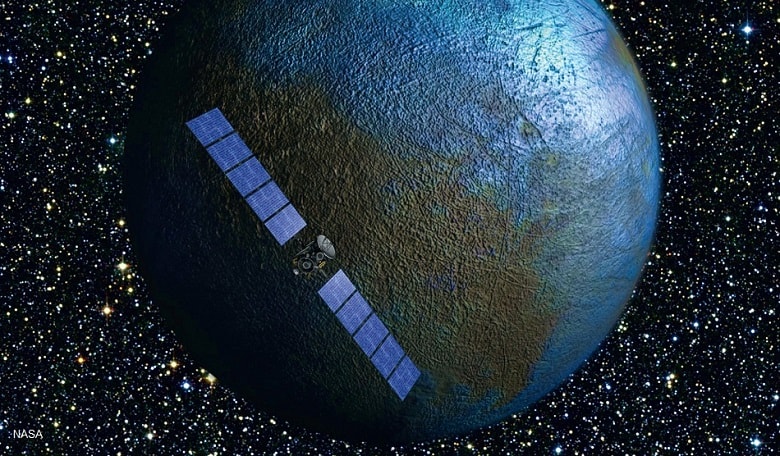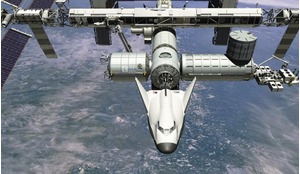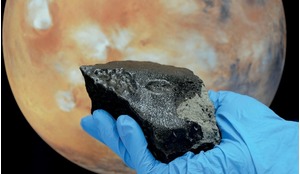Now in the eighth year of its extraordinary extra-terrestrial expedition, the Dawn spacecraft is far from the planet where its journey began. While Earth has completed its repetitive loops around the sun more than seven times, its ambassador to the cosmos has had a much more varied itinerary. It has spent most of its time in space reshaping its orbit around the sun, aiming for some of the last uncharted worlds in the inner solar system.
It also zipped past the oft-visited Mars, robbing the red planet of some of its orbital energy to help fling the spacecraft on to the more distant main asteroid belt. By its fourth anniversary it had arrived at the giant protoplanet Vesta, the second most massive object in the asteroid belt. Spending 14 months exploring the world, it revealed a fascinating, complex, alien place more akin to Earth and other terrestrial planets than to typical asteroids. Now it is again sailing on the celestial seas and in March, it will be at its new, permanent home, dwarf planet Ceres.
The mysterious world of rock and ice is the first dwarf planet discovered (this happened 129 years before Pluto) and the largest body between the sun and Pluto that a spacecraft has not yet visited. Dawn will take up residence there so it can conduct a detailed investigation, recording pictures and other data not only for scientists but for everyone who has ever gazed up at the night sky in wonder.
Dawn is the only spacecraft ever to orbit a resident of the asteroid belt. It is also the only ship ever targeted to orbit two deep-space destinations. This unique mission would be quite impossible without its advanced ion propulsion system, giving it capabilities well beyond what conventional chemical propulsion provides. That is one of the keys to how such a voyage can be undertaken.
Acceleration with patience
Ion propulsion had its origins in solid science, but despite some scientific and engineering work, it resided principally in the fictional universes of Star Trek, Star Wars, and other fanciful stories. NASA’s Deep Space 1 (DS1) mission, which tested ion propulsion and other high-risk technologies, helped bring ion propulsion from the domain of science fiction to science fact.
Dawn is one of DS1’s beneficiaries, and being the first spacecraft ever built to orbit two target bodies after leaving Earth, it would be effectively impossible without ion propulsion.
The inert gas xenon, which is similar to helium and neon but heavier, is used as propellant. Inside the ion thruster, an electron beam, somewhat like the beam that illuminated the screen in televisions prior to a few years ago, bombards the xenon atoms.
When this beam knocks an electron out of an atom, the result is an electrically unbalanced atom: 54 positive charges and 53 negative charges. Now with a net electrical charge of 1 unit, such an atom is known as an ion.
A spacecraft equipped with ion propulsion can achieve 10 times the speed of a craft outfitted with normal propulsion
Because it is electrically charged, the xenon ion can feel the effect of an electrical field, which is simply a voltage. So the thruster applies more than 1000 volts to accelerate the xenon ions, expelling them at speeds as high as 40 kilometres/second (89,000 miles/hour). Each ion, tiny though it is, pushes back on the thruster as it leaves, and this reaction force is what propels the spacecraft. The ions are shot from the thruster at roughly 10 times the speed of the propellants expelled by rockets on typical spacecraft, and this is the source of ion propulsion’s extraordinary efficacy.
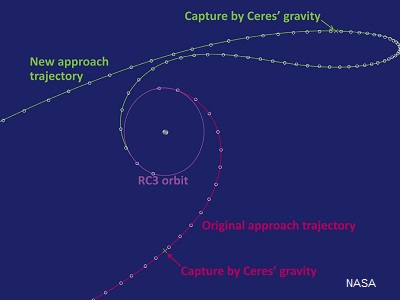 North is at the top of this figure and the sun is far to the left. Ceres orbital motion around the sun carries it straight into the figure. The original approach took Dawn over Ceres’ south pole as it spiralled directly into RC3. On the new approach, it looks here as if it flies in over the north pole, but that is because of the flat depiction. The upper part of the green trajectory is not in the same plane as the original approach and RC3; rather, it is in the foreground, in front of the graphic. As Dawn flies to the right side of the diagram, it also moves back into the plane of the figure to align with the targeted RC3. The circles, spaced at intervals of one day, indicate the spacecraft’s speed; where they are closer together, the ship travels more slowly
North is at the top of this figure and the sun is far to the left. Ceres orbital motion around the sun carries it straight into the figure. The original approach took Dawn over Ceres’ south pole as it spiralled directly into RC3. On the new approach, it looks here as if it flies in over the north pole, but that is because of the flat depiction. The upper part of the green trajectory is not in the same plane as the original approach and RC3; rather, it is in the foreground, in front of the graphic. As Dawn flies to the right side of the diagram, it also moves back into the plane of the figure to align with the targeted RC3. The circles, spaced at intervals of one day, indicate the spacecraft’s speed; where they are closer together, the ship travels more slowly
All else being equal, for the same amount of propellant, a spacecraft equipped with ion propulsion can achieve ten times the speed of a craft outfitted with normal propulsion, or a spacecraft with ion propulsion can carry far less propellant to accomplish the same job as a spacecraft using more standard propulsion.
The rate at which xenon flows through the thruster is very low. At the highest throttle level, the system uses only about 3.25 milligrams/second, so 24 hours of continuous thrusting would expend only ten ounces of xenon. Because the xenon is used so frugally, the corresponding thrust is very gentle. The main engine on some interplanetary spacecraft may provide about 10,000 times greater thrust but, of course, such systems are so fuel-hungry that their ultimate speed is more limited.
The force of the ion thruster on the spacecraft is comparable to the weight of a single sheet of paper. So here is an ion propulsion experiment you may conduct safely at home: hold a piece of paper in your hand, and you will feel the same force that the ion thruster exerts. Because the fuel efficiency is so great, the thruster can provide its push not for a few minutes, like most engines, but rather for months or even years. In the weightless and frictionless conditions of spaceflight, the effect of this thrust can gradually build up to allow the spacecraft to achieve very high speed. Ion propulsion delivers acceleration with patience.
Dawn’s low altitude mapping orbit. This shows how the orbit naturally shifts slightly (relative to the sun) during the three months of LAMO (low altitude mapping orbit
Throughout its mission, Dawn will be farther from the Sun than Earth, but when it was less than twice Earth’s distance from the Sun, those huge solar arrays generated enough power to operate the ion propulsion system at its maximum throttle level. At that setting, the acceleration was equivalent to about seven metres/second/day, or slightly more than 15 miles/hour/day, i.e. one full day of thrusting would change the spacecraft’s speed by seven metres/second (15 miles/hour). That means it would take Dawn 4 days to accelerate from 0 to 60 miles/hour. Perhaps this does not evoke the image of a hot rod, but its parsimonious consumption of xenon lets it thrust for much longer than four days.
To put this in perspective, consider a greatly simplified example based upon the remarkable probes NASA has in orbit around Mars now. When they arrived at the planet, these spacecraft had to burn their engines to drop into orbit. While each mission is different, such a manoeuvre might be about 1000 metres/second (2200 miles/hour) and could consume about 300 kilograms (660 pounds) of propellants. With its ion propulsion system, Dawn could accomplish the same change in speed with less than 30 kilograms (65 pounds) of xenon. A typical Mars mission might complete its manoeuvre in less than 25 minutes, while Dawn might require more than three months. If one has patience, the ion propulsion can be very effective.
For many missions, the greater complexity and cost of ion propulsion is unnecessary, and it is quite clear that we can get into orbit around Mars without it. But as humankind engages in ever more ambitious missions in deep space, the tremendous capability of ion propulsion will be an essential ingredient.
Full throttle
By the end of its mission, having operated from its maximum throttle level down to lower levels now that Dawn is much farther from the Sun, the spacecraft will have accumulated about 5.5 years of total thrust time, giving it an effective change in speed of almost 11 kilometres/second, or well over 24,000 miles/hour. That is about the same as the entire Delta rocket with its nine solid motor strap-ons, first stage, second stage, and third stage, and it is far in excess of what any single-stage craft has accomplished.
Between launch and its seventh anniversary, readers completed seven revolutions around the sun, covering 44.0 AU (4.1 billion miles, or 6.6 billion kilometres). Orbiting farther from the sun, and thus moving at a more leisurely pace, Dawn travelled 31.4 AU (2.9 billion miles, or 4.7 billion kilometres). As it climbed away from the sun to match its orbit to that of Vesta, it continued to slow down to Vesta’s speed. It has been slowing down still more to rendezvous with Ceres. Since Dawn’s launch, Vesta traveled only 28.5 AU (2.6 billion miles, or 4.3 billion kilometres), and the even more sedate Ceres went 26.8 AU (2.5 billion miles, or 4.0 billion kilometres).
The force of the ion thruster on the spacecraft is comparable to the weight of a single sheet of paper
Three years ago, the spacecraft’s path around the sun was exactly the same as Vesta’s. Achieving that perfect match was, of course, the objective of the long flight that started in the same solar orbit as Earth, and that is how Dawn managed to slip into orbit around Vesta. While simply flying by it would have been far easier, matching orbits with Vesta required the exceptional capability of the ion propulsion system. Without that technology, NASA’s Discovery Program would not have been able to afford a mission to explore it in such detail. But now, Dawn has gone even beyond that. Having discovered so many of Vesta’s secrets, the stalwart adventurer left the protoplanet behind. No other spacecraft has ever escaped from orbit around one distant solar system object to travel to and orbit still another extra-terrestrial destination. A true interplanetary spaceship, Dawn is enlarging, reshaping and tilting its orbit again so that in March, it will be identical to Ceres’.
While trajectories that use ion propulsion are much more complicated, that fundamental principle applies. Indeed, Dawn’s speed toward Ceres has been declining since December 2013. In addition to the recent and future ion thrusting that guides the ship smoothly into its new port, the gravity of Ceres itself will help tug Dawn in.
Space strike
1. Dawn’s first extended picture of Ceres was only slightly larger than this image of Vesta taken on 3 May 2011, at the beginning of the Vesta approach phase. The inset shows the pixelated Vesta, extracted from the main picture in which the overexposed Vesta can be seen against the background of stars
2. The Dawn spacecraft observed Ceres for an hour on Jan. 13, 2015, from a distance of 238,000 miles (383,000 kilometers
3. This mosaic synthesizes some of the best views that Dawn had of Vesta. It studied Vesta from July 2011 to September 2012. The towering mountain at the south pole — more than twice the height of Mount Everest — is visible at the bottom of the image. The set of three craters known as the “snowman” can be seen at the top left
On 11 September, as the spacecraft was engaged in routine ion thrusting, a high-energy particle of space radiation struck an electrical component onboard. That triggered a chain of events that halted thrusting and required the team of flight controllers on distant Earth to leap into action to resume normal operations. Their swift and expert response was successful, and by 15 September the robot was back on duty.
By the time Dawn was once again perched atop its blue-green pillar of xenon ions, it had missed about 95 hours of thrusting. That had surprising and interesting consequences for the approach to Ceres, and has provided a fascinating illustration of the creativity of trajectory designers and the powerful capability of ion propulsion.
Throughout last year, the flight team had made incremental improvements in the thrust plan, and gradually the Ceres arrival date has shifted earlier by several weeks from what had been anticipated a year ago. Today Dawn is on course for easing into Ceres’ gravitational embrace on 6 March. The principal effect of the missed thrust is to make the initial orbit larger, so the spaceship will need more time to gently adjust to a circular, polar orbit at 13,500 kilometres (8,400 miles). It will reach that altitude on about 23 April which, as it turns out, differs by less than a week from the schedule last year.
During the approach phase, the spacecraft interrupts thrusting occasionally to take pictures of Ceres against the background stars, principally to aid in navigating the ship to the uncharted shore ahead. The first “optical navigation” photos were taken on 13 January. The onboard camera, designed for mapping Vesta and Ceres from orbit, showed a fuzzy orb 27 pixels across.
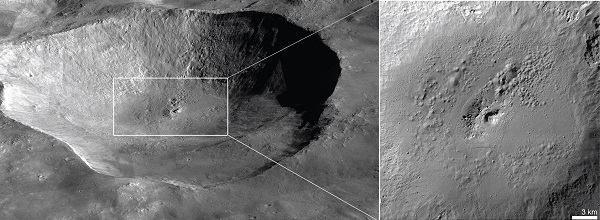 A color-coded topography map of Vesta. It was constructed following analysis of over 17,000 images from Dawn’s framing camera
A color-coded topography map of Vesta. It was constructed following analysis of over 17,000 images from Dawn’s framing camera
Although the pictures did not yet display details quite as fine as those already discerned by Hubble Space Telescope, the different perspective is intriguing. The pictures from the second approach imaging session in late January were slightly better than Hubble’s, and the third set acquired on 4 February, were twice as good as what we have today. By the time of the second “rotation characterization”, around 20 February, the pictures were seven times better than Hubble’s.
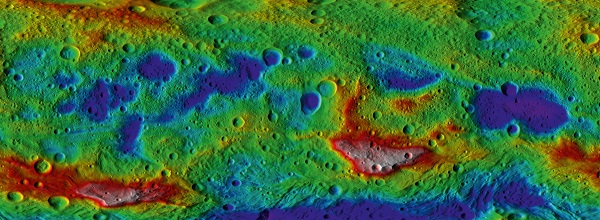 The Marcia crater on Vesta, reproduced from multiple images taken by Dawn
The Marcia crater on Vesta, reproduced from multiple images taken by Dawn
The difference in perspectives between Dawn’s camera and the Hubble Space Telescope is intriguing
While the primary purpose of the approach photos is to help guide Dawn to its orbital destination, the images (and visible and infrared spectra collected simultaneously) serve other purposes. They provide some early characterisations of the alien world so engineers and scientists can finalise sensor parameters to be used for the many subsequent observations. They are also being used to search for moons. And the pictures surely thrill everyone along for the ride as a mysterious fuzzy patch of light, observed from afar for more than two centuries and once called a planet, then an asteroid, and now a dwarf planet, finally comes into sharper focus. Wonderfully exciting though they are, the views draw us onward with their promises of still more discoveries ahead.
References
Marc’s Dawn journals can be read at http://dawn.jpl.nasa.gov/mission/journal.asp





